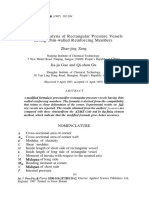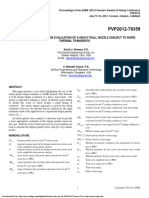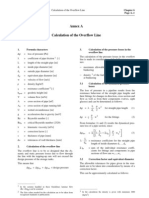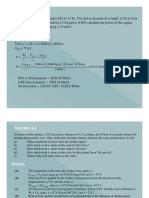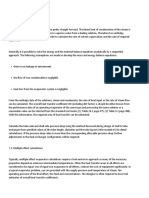Stresses at Junction of Cone and Cylinder in Tanks With Cone Bottoms or Ends - Boardman
Stresses at Junction of Cone and Cylinder in Tanks With Cone Bottoms or Ends - Boardman
Uploaded by
hawkwhiteCopyright:
Available Formats
Stresses at Junction of Cone and Cylinder in Tanks With Cone Bottoms or Ends - Boardman
Stresses at Junction of Cone and Cylinder in Tanks With Cone Bottoms or Ends - Boardman
Uploaded by
hawkwhiteOriginal Title
Copyright
Available Formats
Share this document
Did you find this document useful?
Is this content inappropriate?
Copyright:
Available Formats
Stresses at Junction of Cone and Cylinder in Tanks With Cone Bottoms or Ends - Boardman
Stresses at Junction of Cone and Cylinder in Tanks With Cone Bottoms or Ends - Boardman
Uploaded by
hawkwhiteCopyright:
Available Formats
Table II
Stresses at Junction of Cone and Cylinder
in Tanks with Cone Bottoms or Ends
By H. C. Boardman, Research Engineer
EDITORS NOTE: The war has stimulated the that the end of the cylinder strip and the end of
building of large, heavy pressure vessels of all the cone strip must deflect and rotate together.
kinds and shapes. A number of these have cone Let:
heads, or cone bottoms, of a size considerably F = Radial load on end of cone strip in Ibs.
larger than encountered a few years ago. Steel f= Radial load on end of cylinder strip in Ibs.
plate designers have long known that com- The longitudinal bending stress at the end of the
M =Moment on adjoining ends of cone and cylinder
pression stresses exist at the junction of a strips in lb.—ins. t2 6M
cylindrical shell with a cone bottom and have cylinder strip = M 2 .The membrane
Fig. II shows F, f, and M acting on the strip ends. 6 t
made calculations of such stresses. The manner of
providing reinforcing and the extent of rein- pR
longitudinal stress is . Therefore the com-
forcing to be used, however, has always been a 2t
question. The ASME and API- ASME Codes are bined bending and direct stresses at the end of the
silent, both as to the stresses themselves and the cylinder strip=
manner and extent of reinforcing to be provided.
To the best of our knowledge, a satisfactory
solution has never been worked out. The subject The circumferential stress (See Table I) at end of
is necessarily rather involved and designers have Figure II cylinder strip due to "f" and
been satisfied with the use of approximate
methods. In the following article, Mr. Boardman The theory of beams on elastic foundations (See
has endeavored to give the problem the Chapter I, Part II, Timoshenko's STRENGTH OF
consideration that it deserves. MATERIALS) leads to the practically accurate
expressions for the ends of the cylinder and cone
The membrane circumferential tension at the end of
strips shown in Table I below.
pR
Using these values and Figures I and II the the cylinder = . Therefore the total circum-
t
following equations may be written:
ferential stress at the end of the cylinder =
(I) F+f =1/2pR tan =Z
pR
(II) Fzcos2—Mzcos2=fz—Mz or F cos2— 1316
t
.
R
V1 2V2 tan , a minus sign
Mcos2=f—M t
Radial deflection (perpendicular to axis) of end of indicating compression.
cone strip due to " F" minus radial deflection of Let X=4.559(tan)V2 and Y=1.316 tan (V1-2V2).
end of cone strip due to " M" = radial deflection of Then a general expression for the longitudinal
end of cylinder strip due to " f" minus radial
Fig. I represents the end of a strip of cylinder 1 deflection of end of cylinder strip due to "M." stress at the end of the cylinder is
pR
t
.5 X Rt ;
in. wide circumferentially adjoining the end of a (III) Fzcos2-2Mz2cos2=2Mz2-fz or
Fcos2=f-M and a general expression for the circumferential
strip of cone 1 in. wide circumferentially. Under
an internal gas pressure of " p" Ibs. per sq. in.,
cylinder and cone strip ends of the relative
Rotation of end of cone strip due to "F" minus
rotation of end of cone strip due to "M"=rotation
stress at the end of the cylinder is
pR
t
1 Y Rt
thicknesses shown would obviously move radially of end of cylinder strip due to "M" minus rotation Table III summarizes the foregoing analysis, and
outward (perpendicular to the cylinder and cone of end of cylinder strip due to " f." also gives values of (.012°) and (.005°) which are
axis) the same distance provided a radially The solutions of equations (I), (II) and (111) are: practical equivalents of X and Y, respectively.
outward force of (1/2pR tan ) acted as indicated.
In fact, however, no such force exists. Therefore It is apparent from a study of the expression
the cone and cylinder together must resist a
radially inward force of (1/2pR tan ) per inch of in which
pR
t
.5 Rt that the longitudinal stresses are very
circumference of the cone-cylinder junction circle.
high for pressure vessels of common proportions.
To determine the resulting stresses, which are
However, these stresses are of the same nature as
eventually to be combined with the membrane
stresses, it is necessary to set up and solve those in the hubs of bolted flanged connections,
equations stating mathematically and do not exist, in the intensities calculated, after
the application of the test pressure. For this reason
Table I it seems reasonable to ignore them in designing,
and to think of the plastic longitudinal
deformation under test as the final fabricating
operation.
It also seems reasonable to permit at the
cone-cylinder junction a circumferential com-
pR
pression stress of as calculated from the
t
expression
pR
t
1 Y Rt , even though it is
realized that the value thus calculated is in error
because of the above discussed plastic yielding in
the longitudinal direction. In fact, plastic yielding
circumferentially as well as longitudinally under
the test pressure may be considered normal
provided no buckling occurs.
Although further analytical and experimental data
are needed to conclusively establish this basis for
REPRINTED FROM THE WATER TOWER,1944
205
The solution may be made easily by trial; or by the
safe but approximate equation,
Of course the corresponding cone thickness
T
. For "Y" its practical equivalent (.005)
cos
may be used.
It is recommended that the increased cylinder
thickness extend over a shell width (measured
longitudinally) of at least 2 1 3 RT inches, and
that the increased cone thickness extend over a
width (measured along a cone element) of at
RT
least 2 1 3 inches.
cos
CAUTION: This analysis is directly applicable only when
the cylinder thickness is equal to the cone thickness times
(cos), and when the pressure is due to gas.
Table IV may be used to plot the curves of
Deflection, Rotation, Moment (and corresponding
longitudinal stress), Shear and Circumferential
Stress for a cylinder strip; the same expressions are
practically correct for a cone strip provided loads,
shears, and deflections be perpendicular to the
R
strip, be used instead of (R), and (I) be
cos
the actual moment of inertia of the cone strip
cross-section. In the Table, (e) is the base of the
Natural system of logarithms, and (x) is the
distance in inches from the end of the strip.
design, it is supported by available test and in decimal form), to keep down to the maximum
experience records. of " SE" above set, the calculated ring com-
On this basis the maximum permissible pressive stress at the cone-cylinder junction. In
this case the cylinder thickness required is
2
2 obtained by solving for "T" the cubic equation
calculated value of Y R is 2, i.e., is the
t Y
R
largest value of which can be permitted
t
without the installation of a compression ring at
R
the cone cylinder junction. For ratios larger
t
than 2, a compression ring is required with a
cross-sectional area of
If for"Y" its practical equivalent (.005) is used,
the expression becomes
Also, for practical purposes, the maximum (R/t)
2
400
ratio without a compression ring is .
If no compression ring is to be used, even
though R t be larger than 2/Y, the cylinder and
cone plates can be made sufficiently thicker than
pR/SE and pR/(SEcos), respectively (where
S=working stress, lbs. Per sq. in., and E-joint
efficiency, Three typical field-erected tanks with cone bottoms
and roofs. They are 30 ft. in diam.
206
You might also like
- AISC Steel Construction Manual ASD 7th Edition 1st Impression 1973Document1,066 pagesAISC Steel Construction Manual ASD 7th Edition 1st Impression 1973Eric Wilkins100% (3)
- Q Criterion PDFDocument46 pagesQ Criterion PDFchawarepNo ratings yet
- Solution Manual For Introduction To Quantum Mechanics 2nd Edition by Griffiths PDFDocument11 pagesSolution Manual For Introduction To Quantum Mechanics 2nd Edition by Griffiths PDFa18236036086% (7)
- Watts - Stresses in A Pressure Vessel With A Conical HeadDocument13 pagesWatts - Stresses in A Pressure Vessel With A Conical Headm5416100% (2)
- For Buildings and Other Structures For Wind LoadsDocument28 pagesFor Buildings and Other Structures For Wind LoadsMarinos Giannoukakis100% (1)
- Design of Tooth Locked Quick Open Die Pressure VesselDocument4 pagesDesign of Tooth Locked Quick Open Die Pressure VesselSEP-PublisherNo ratings yet
- Dennis R Moss 4th EditionDocument5 pagesDennis R Moss 4th Editionsenthil kumarNo ratings yet
- f201508151439617857 PDFDocument6 pagesf201508151439617857 PDFh_alimohamNo ratings yet
- Mec30 LectureDocument142 pagesMec30 LectureDean Ackles100% (1)
- Example On Is 1893Document27 pagesExample On Is 1893abhi6488No ratings yet
- Structurally Supported Conical RoofDocument10 pagesStructurally Supported Conical Rooframu karriNo ratings yet
- Fatigue Evaluation of Pressure Vessel Using Finite Element Analysis Based On ASME BPVC Sec VIII Division 2Document13 pagesFatigue Evaluation of Pressure Vessel Using Finite Element Analysis Based On ASME BPVC Sec VIII Division 2Tanawit SaitinNo ratings yet
- Zeng 1987Document12 pagesZeng 1987obaidullah.dsuNo ratings yet
- Mandatory Appendix 9Document2 pagesMandatory Appendix 9Asep DarojatNo ratings yet
- Imp-Pvp2012-78359-Elastic-Plastic Fatigue Evaluation of A Heavy Wall Nozzle Subject To Rapid Thermal TransientsDocument10 pagesImp-Pvp2012-78359-Elastic-Plastic Fatigue Evaluation of A Heavy Wall Nozzle Subject To Rapid Thermal Transientsbomika100% (1)
- Analysis of Vertical Vessels Supported On Legs By: Ray DelaforceDocument6 pagesAnalysis of Vertical Vessels Supported On Legs By: Ray Delaforcesonali panditNo ratings yet
- 5 Asmeviii A-24 Clamp ConnectionDocument6 pages5 Asmeviii A-24 Clamp ConnectionpastylNo ratings yet
- Api 579Document8 pagesApi 579pouya_ms100% (1)
- Nozzle Reinforcement CalculationsDocument11 pagesNozzle Reinforcement CalculationsmshNo ratings yet
- Stresses in Large Horizontal Cylindrical Pressure Vessels On Two Saddle SupportsDocument12 pagesStresses in Large Horizontal Cylindrical Pressure Vessels On Two Saddle SupportsAnonymous qhVGVpNo ratings yet
- 3D Stress CriteriaDocument5 pages3D Stress CriteriaFernando Diez100% (1)
- BS 470 Entry PVDocument8 pagesBS 470 Entry PVbonnicoNo ratings yet
- ASME 2286-2 Alternative Rules For Determining Allowable External PressureDocument16 pagesASME 2286-2 Alternative Rules For Determining Allowable External PressureMike Dukas100% (1)
- BS 5276-2Document20 pagesBS 5276-2Ali Alizadeh100% (1)
- Chapter b04 Stress Analysis of Piping System PDFDocument108 pagesChapter b04 Stress Analysis of Piping System PDFrogel_ganaNo ratings yet
- ASME Code Case 2901Document2 pagesASME Code Case 2901sudokuNo ratings yet
- API 650 5.11.2 and F.4.2 Uplift CriteriaDocument1 pageAPI 650 5.11.2 and F.4.2 Uplift Criteriaonin007No ratings yet
- Overflow Line DesignDocument2 pagesOverflow Line DesignAngshuman Roy ChoudhuryNo ratings yet
- Hydrodynamic Calculation Howell-Bunger ValveDocument31 pagesHydrodynamic Calculation Howell-Bunger ValveEng-CalculationsNo ratings yet
- TEMA Eighth Edition - ClarificationsDocument13 pagesTEMA Eighth Edition - ClarificationsJerome100% (1)
- Sa 266Document5 pagesSa 266Alejo ZabalaNo ratings yet
- Stress Analysis Using Autodesk InventorDocument9 pagesStress Analysis Using Autodesk InventorAgus PrijantoNo ratings yet
- Agitator FINITE ELEMENT METHODDocument5 pagesAgitator FINITE ELEMENT METHODRoopesh S AcharyaNo ratings yet
- Basket Burst PressureDocument1 pageBasket Burst Pressurexaaabbb_550464353No ratings yet
- Buoyancy CalculationDocument11 pagesBuoyancy CalculationDuong VuNo ratings yet
- 212.nozzle Load Stress Analysis Using WRC 107 and WRC 297Document4 pages212.nozzle Load Stress Analysis Using WRC 107 and WRC 297jeronimo113No ratings yet
- P17-1TS-KBR Bolting Types Carbon & Alloy SteelDocument2 pagesP17-1TS-KBR Bolting Types Carbon & Alloy Steelyulianus_sr100% (1)
- Mid Term PrepDocument16 pagesMid Term PrepMarcos Orlando Calla CondoriNo ratings yet
- Pressure Vessel Design Manual (Moss) 205Document1 pagePressure Vessel Design Manual (Moss) 205anu radha100% (1)
- IBR DetailsDocument10 pagesIBR DetailsArindomNo ratings yet
- Structural Strength Assessment For Unlined Steel Stack Using Finite Element Analysis Cst-1017Document8 pagesStructural Strength Assessment For Unlined Steel Stack Using Finite Element Analysis Cst-1017Srinivasa Rao VenkumahanthiNo ratings yet
- Pulsating Heat Pipe ReportDocument65 pagesPulsating Heat Pipe ReportIdul Azharul HoqueNo ratings yet
- Gasket Effective Dia For Spiral Wound Metallic Gaskets Per B16.20 For ASME B16.5 FlangesDocument2 pagesGasket Effective Dia For Spiral Wound Metallic Gaskets Per B16.20 For ASME B16.5 FlangesGaurav BhendeNo ratings yet
- Buckling of Thin Metal Shells 291Document1 pageBuckling of Thin Metal Shells 291pawkom100% (1)
- Flat Ends With A Hub For Uniform Thickness ShellDocument5 pagesFlat Ends With A Hub For Uniform Thickness ShellEng-CalculationsNo ratings yet
- Rectangular Tubesheet Design Guideline by HEIDocument6 pagesRectangular Tubesheet Design Guideline by HEIm5416No ratings yet
- Etab RSM Eccc Basics SCMDocument2 pagesEtab RSM Eccc Basics SCMsathiyaseelann.sNo ratings yet
- Done By: 1. Giyon Bezabh 0572/10 2. Mikiyas Adefa 0837/10Document50 pagesDone By: 1. Giyon Bezabh 0572/10 2. Mikiyas Adefa 0837/10Mikey CouthinhoNo ratings yet
- Dokumen - Tips - On The Buckling Analysis and Design of Silos and TanksDocument22 pagesDokumen - Tips - On The Buckling Analysis and Design of Silos and TanksSalim TurkNo ratings yet
- ISO 4126-7-2004 Pressure Safety Valve (COMMON DATA)Document40 pagesISO 4126-7-2004 Pressure Safety Valve (COMMON DATA)Pushkar GopalNo ratings yet
- Gasket EquationsDocument7 pagesGasket EquationscutefrenzyNo ratings yet
- Code Case 2901 Nozzle S1 SL No Description Unit Value: Provided Nozzle Flange Is Safe For External LoadingsDocument1 pageCode Case 2901 Nozzle S1 SL No Description Unit Value: Provided Nozzle Flange Is Safe For External LoadingsguravdrNo ratings yet
- Roark's Formulas For Stress and StrainDocument49 pagesRoark's Formulas For Stress and StrainchiragNo ratings yet
- B04-F03 REV 1 March 2018 Pipe RailignsDocument4 pagesB04-F03 REV 1 March 2018 Pipe Railigns15150515715No ratings yet
- Nozzle Interference Error SolvingDocument2 pagesNozzle Interference Error SolvingSakthi Vel0% (1)
- TRD 301 Annex 1 Design PDFDocument14 pagesTRD 301 Annex 1 Design PDFarjun prajapatiNo ratings yet
- Beam Column CompositeDocument57 pagesBeam Column CompositeChristina HeryesNo ratings yet
- Structural Engineering IV - Chapter 5 (Bending Members)Document22 pagesStructural Engineering IV - Chapter 5 (Bending Members)Haftom GebreegziabiherNo ratings yet
- (Meng) Mechanical Design of Rocket MotorsDocument31 pages(Meng) Mechanical Design of Rocket MotorsYudi RahmanNo ratings yet
- Pressure Uessel and Piping CadesDocument9 pagesPressure Uessel and Piping CadesJoão Paulo VissottoNo ratings yet
- Filament Winding Shape OptimizationDocument14 pagesFilament Winding Shape OptimizationDanielNo ratings yet
- DummyDocument12 pagesDummyrajkamal eshwarNo ratings yet
- Chapter - 3Document64 pagesChapter - 3Samuel GosayeNo ratings yet
- Cylindrical Compression Helix Springs For Suspension SystemsFrom EverandCylindrical Compression Helix Springs For Suspension SystemsNo ratings yet
- Problem - 6A PDFDocument6 pagesProblem - 6A PDFMonicaNo ratings yet
- TM 5-856-5Document239 pagesTM 5-856-5pitheintegerNo ratings yet
- Summary - Part III 2017-2018 Extended PDFDocument180 pagesSummary - Part III 2017-2018 Extended PDFPythonraptorNo ratings yet
- Hydro Turbine and Governor ModellingDocument149 pagesHydro Turbine and Governor ModellingMecanical Xeset1-2 HPP100% (1)
- 2012 - G.monteiro - Optical and Spectroscopic Properties of Erbium Doped Germanotellurite Glasses - InPress-corrected Proof VersionDocument14 pages2012 - G.monteiro - Optical and Spectroscopic Properties of Erbium Doped Germanotellurite Glasses - InPress-corrected Proof VersionPhước TrầnNo ratings yet
- Anton Paar MCRDocument12 pagesAnton Paar MCRIvona IvkovicNo ratings yet
- Ce 107 Module 7 Influence LinesDocument10 pagesCe 107 Module 7 Influence LinesArKaDaTa21 ValienteNo ratings yet
- Design of Slide Gate Size 1.6 X 2 MDocument4 pagesDesign of Slide Gate Size 1.6 X 2 MTarunPatra100% (3)
- HT QSTNS PDFDocument2 pagesHT QSTNS PDFMannam Sarath SarathNo ratings yet
- PGTRB Chemistry Unit 1 Study Materials English MediumDocument24 pagesPGTRB Chemistry Unit 1 Study Materials English MediumPAUL RAJNo ratings yet
- Spudcan Penetration in Sand Overlying ClayDocument6 pagesSpudcan Penetration in Sand Overlying ClayhiyeonNo ratings yet
- Gear VibrationsDocument11 pagesGear Vibrationshumayun121No ratings yet
- AASHTO LRFD 7th Ed - Load Factors and CombinationsDocument10 pagesAASHTO LRFD 7th Ed - Load Factors and CombinationsgemotorresNo ratings yet
- A New Method To Measure Viscosity and Intrinsic Sound Velocity of Liquids Using Impedance Tube Principles at Sonic Frequencies 2004Document8 pagesA New Method To Measure Viscosity and Intrinsic Sound Velocity of Liquids Using Impedance Tube Principles at Sonic Frequencies 2004vitor_pedroNo ratings yet
- ReferencesDocument6 pagesReferencesAnuj_Kanwal_1156No ratings yet
- Mechanics: Mechanics Is The Subdivision of Physics Which Addresses Equilibrium andDocument7 pagesMechanics: Mechanics Is The Subdivision of Physics Which Addresses Equilibrium andShakeel ChughtaiNo ratings yet
- Fluid-Mechanics SyllabusDocument8 pagesFluid-Mechanics SyllabusMarky SantosNo ratings yet
- Robert Martin Eisberg Fundamentals of Modern Physics John WileyDocument750 pagesRobert Martin Eisberg Fundamentals of Modern Physics John WileyFelipe Martins100% (1)
- ELE 4623: Control Systems: Faculty of Engineering TechnologyDocument15 pagesELE 4623: Control Systems: Faculty of Engineering TechnologyMaitha SaeedNo ratings yet
- Vaporizer MBDocument4 pagesVaporizer MBnedian_2006No ratings yet
- Mech III & IV NMAMIT SyllabusDocument27 pagesMech III & IV NMAMIT SyllabusHn NayakNo ratings yet
- (AMCP 706-283) - Engineering Design Handbook - Ballistic Missile Series - Aerodynamics - U.S. Army Materiel CommandDocument98 pages(AMCP 706-283) - Engineering Design Handbook - Ballistic Missile Series - Aerodynamics - U.S. Army Materiel CommandSoufiane HazelNo ratings yet
- CSU-Cabadbaran Advance Review For EE: Topic: Mechanics 1 - StaticsDocument10 pagesCSU-Cabadbaran Advance Review For EE: Topic: Mechanics 1 - StaticsCinderella WhiteNo ratings yet
- Course Guide - General Physics 1 SY 2020-2021Document7 pagesCourse Guide - General Physics 1 SY 2020-2021Naega HoshNo ratings yet
- Phet Energy Skate ParkDocument4 pagesPhet Energy Skate Parkapi-268569185No ratings yet
- Solid Mechanics Practical - Virtual Lab LinksDocument4 pagesSolid Mechanics Practical - Virtual Lab LinksARJUNANo ratings yet












